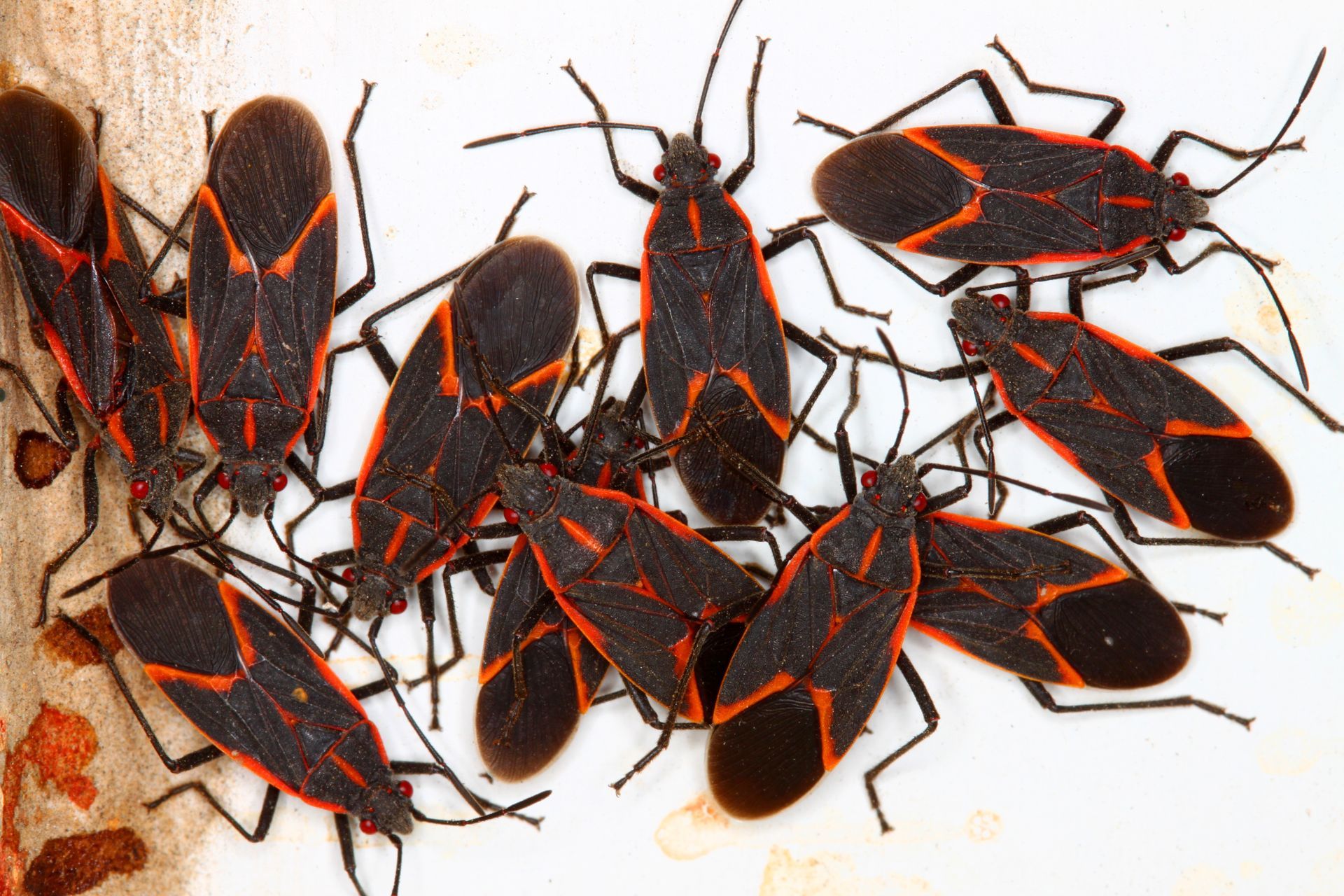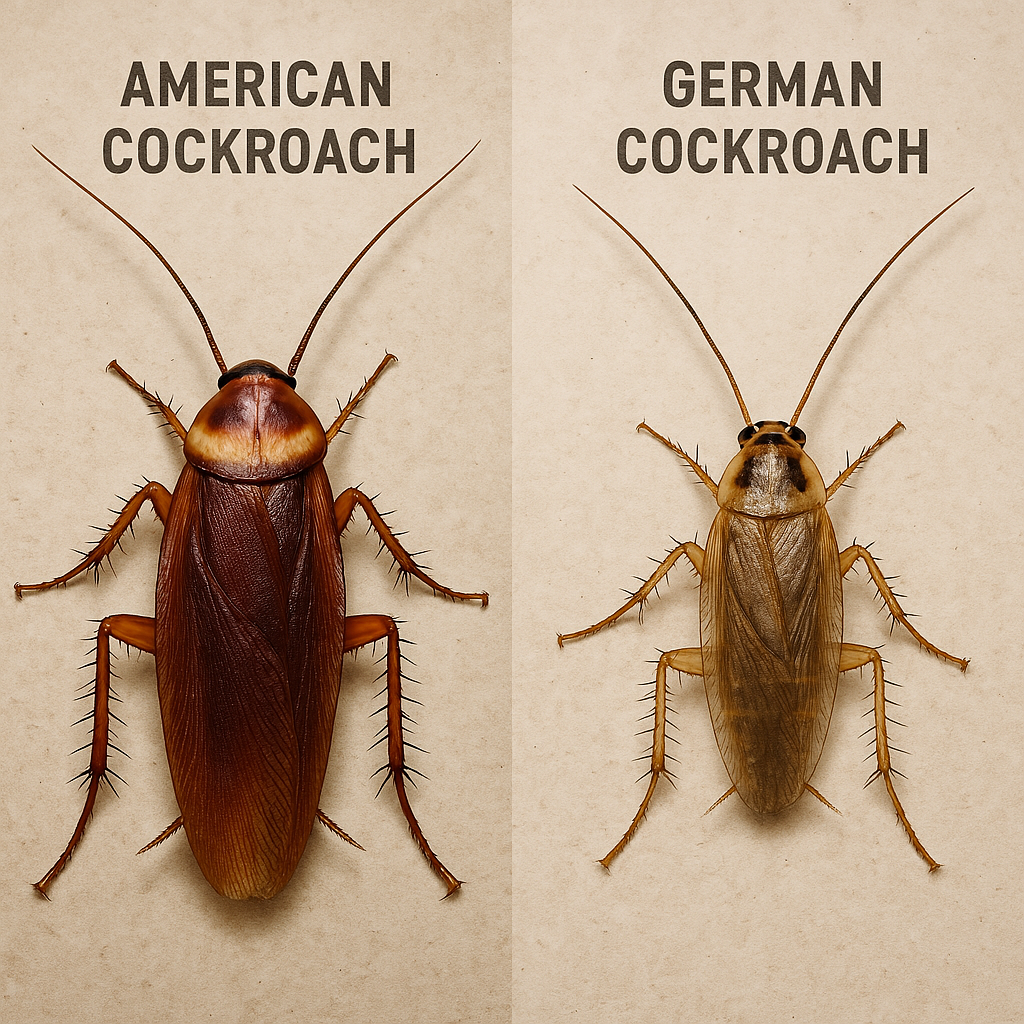What Are Boxelder Bugs?

Boxelder bugs are a common North American insect that gets their name from the trees they rely on for food and shelter, the boxelder tree. These trees have been used as both ornamental trees as well as trees that provide erosion control so they are found all over the US. While boxelder bugs prefer boxelder trees, they are also known to feed on other maple and fruit trees. They do not do enough damage to impact the growth of the trees they feed on which makes them a neutral pest since they provide little impact on their ecosystems. Regardless, they are still a nuisance pest that will aggregate in large numbers on the trees they feed on before eventually looking for warm places to overwinter like your home.
Boxelder Bug Identification
Boxelder bugs are a true bug that can reach up to a ½ inch long at maturity. Adult boxelder bugs have a flattened, oval, black body with red markings, red eyes, six legs, and long antennae. That elongated body is covered by 2 black wings with red ridges that lay over each other when not being used. When the wings are laid back, the red edges create an “X” or “W” pattern on the back of the boxelder bug. Boxelder nymphs are usually smaller versions of adults but with bright red bodies that don’t darken or develop the darkened wings until the final couple molts. Boxelder nymphs are typically clustered together to create bright red patches of bugs that cover the surface of boxelder trees.
Boxelder Bug Behavior
Boxelder bugs can typically be found on boxelder trees because their nymphs primarily feed on boxelder seed pods. These bugs will spend much of the year sunning themselves on the outside of boxelder trees or other maple and ash trees to stay warm, but that behavior shifts when temperatures drop. As it gets colder in the fall, boxelder bugs will start to migrate to anywhere warm that they can find to overwinter. Sometimes this results in boxelder bugs taking refuge deep inside tree cavities, but other times boxelder bugs will find cracks and crevices that lead inside a home. If boxelder bugs gain access into a home and find a safe place to lay low during the colder months, they will release an aggregation pheromone that attracts other boxelder bugs. During the winter, boxelder bugs will mostly remain dormant in a hibernation phase which makes their presence less invasive. That being said, as external temperatures rise, boxelder bugs will become active and start to look for ways to get back outside where they can find boxelder trees to feed on and start their reproduction cycle.
Life Cycle of Boxelder Bugs
The boxelder bug life cycle starts every spring when adult boxelder bugs awaken from their winter hibernation. During this time, boxelder bugs will return outside in search of boxelder trees to feed on to regain their strength. After several weeks of feeding, boxelder bugs will seek out female seed bearing boxelder trees to lay clusters of eggs on. By mid-July, these eggs can be found in large clusters all over boxelder trees in the US. These eggs will hatch into bright red boxelder nymphs that will spend the rest of the year reaching maturity.
Boxelder bugs that reach maturity by the start of fall will start to leave their boxelder trees in search of places to stay warm during the upcoming winter. While mature boxelder bugs will continue to lay eggs throughout the year, any boxelder nymphs that do not reach maturity by the time temperatures drop will not survive the winter. By late fall, boxelder bugs will have found a safe spot to lay dormant while they wait out the winter.
Where Do Boxelder Bugs Live?
Boxelder bugs get their name from the boxelder trees they prefer to live and feed on. They are also known to take residence on other maple and ash trees that are similar to boxelder trees. They can also be found on fruit trees that provide soft fruits to feed on. During the year, boxelder bugs will be found on the surface of these trees facing the sun. This is because boxelder bugs will be absorbing the heat of the sun during the day before returning to living under tree bark where they can remain warm. Once daytime temperatures start to drop to uncomfortable levels, boxelder bugs will start to look for warm places to hibernate.
What Do Boxelder Bugs Eat?
Boxelder bugs are sap suckers that use a thin proboscis to extract the juices from leaves and fruits of the trees they inhabit. Boxelder nymphs rely on boxelder seed pods as their primary source of food which is why reproducing boxelder bugs are typically found on or near female boxelder trees. Adult boxelder bugs can be found on boxelder, maple, ash, plum, and apple trees. While adult boxelder bugs mostly feed on the leaves of these trees, they can also feed on the fruit. This results in fruit appearing bruised, scarred, deformed, and damaged.
Are Boxelder Bugs a Threat?
Boxelder bugs are considered a neutral pest due to them not having any significant positive or negative impact on their ecosystems.
Do Boxelder Bugs Bite?
While anecdotal reports of boxelder bugs biting exist, it doesn’t make sense for them to do so given they are unable to feed on or defend themselves from humans using their proboscis. Boxelder bugs are strictly herbivores and are incapable of biting due to their anatomy. These bugs don’t have chewing mouthparts and rely more on a straw like proboscis to suck the fluids out of leaves.
Damages Caused by Boxelder Bugs
Instead of causing harm, boxelder bugs can cause some minor damages to the leaves and fruits they feed on.
Outdoor Damages
Outdoor damages caused by boxelder bugs is the result of them extracting the fluids from whatever they feed on. They use their proboscis to drain the fluids from leaves and fruits which causes browning, bruising, and scarring. This damage is largely aesthetic and doesn’t have too much impact on the health of the plant. However, leaves that are drained of their fluids have difficulty photosynthesizing and fruits will appear with brown spots or bruising which can make the fruit unsellable.
Indoor Damages
While boxelder bugs are considered a neutral pest based on the damage they do to plants, they have the potential to cause more damage indoors. These bugs will aggregate indoors in large numbers and while they do not contribute to any structural damage or contaminate food like other pests do, their fecal matter will stain fabrics a reddish color. They can also leave a bright red stain if they are smashed or crushed.
Do Boxelder Bugs Smell?
The other issue with boxelder bugs is that they rely on a defense mechanism similar to stink bugs. They produce an odor and taste that is extremely unpleasant and designed to deter predators who may decide to try and feed on these bugs. Another similarity they have to stink bugs, is they produce an aggregation pheromone that attracts other boxelder bugs. When this occurs and large numbers of boxelder bugs gather, the accumulated smell of hundreds of boxelder bugs is much more noticeable to potential predators.
Signs of a Boxelder Bug Infestation
Boxelder bug infestations typically start outside before they ever move indoors. Signs of a boxelder bug infestation outside include finding large clusters of boxelder bugs on the surface of trees anytime from late spring to late fall. Once winter arrives, signs of boxelder bug activity will move indoors. Visible signs of boxelder bug activity include large clusters of boxelder bugs or the reddish fecal stains that boxelder bugs leave behind.
How to Prevent Boxelder Bugs Outside
The best way to stop boxelder bugs is to prevent them altogether. This starts outside through exclusion strategies and eliminating the things that attract boxelder bugs.
Exclusion strategies include:
- Sealing possible access points including cracks, crevices, and gaps in the foundation, stucco, or plaster around a building
- Repairing damages or torn window and door screens
- Repairing damages vent covers and vent screens
- Seal access points around electrical, phone, cable, and plumbing lines
- Install door sweeps
- Fill gaps under fascia board or siding with an appropriate filler
The other thing that can be done to get rid of boxelder bugs is to remove boxelder trees. With that being said, it is important to note that boxelder bugs can travel long distances so eliminating boxelder trees around a property may not be feasible if there are boxelder trees outside of property lines. Instead of removing boxelder trees, these bugs can be sprayed down using a soapy water mix which should knock them down and hopefully deter them from coming back.
How to Prevent Boxelder Bugs Inside
Getting rid of boxelder bugs once they are inside can usually be done with a vacuum cleaner to prevent smashing the boxelder bugs and leaving a red stain. When large populations are discovered inside, this method is likely the easiest way to safely remove boxelder bugs. If boxelder bugs are discovered inside wall voids, it is best to wait until spring so the boxelder bugs vacate their hiding spot before applying treatment. This is because boxelder bugs that are treated and die may attract other bugs.
Contact EcoGuard Pest Management if You Are Dealing with Boxelder Bugs
If you are currently dealing with a boxelder bug infestation, it may be time to enlist the help of qualified professionals to eliminate your boxelder bug problem. EcoGuard Pest Management has a team of licensed and trained boxelder bug experts standing by to provide you with an inspection and treatment. Our integrated pest management approach combines treatment with exclusion strategies and ongoing maintenance to ensure that boxelder bugs don’t pose an on-going problem. Call today to schedule an inspection!

















